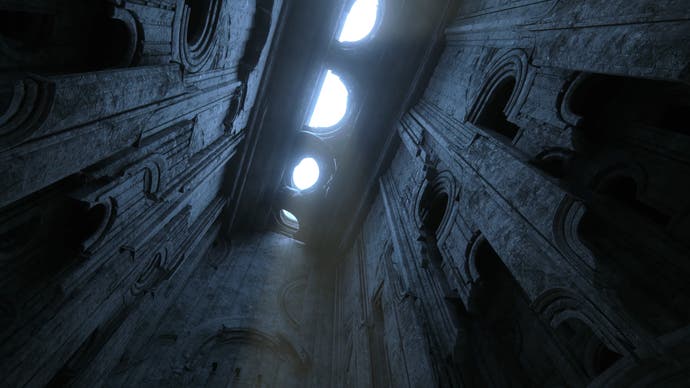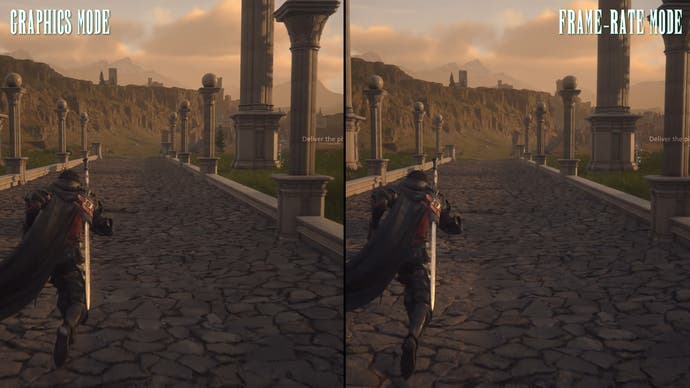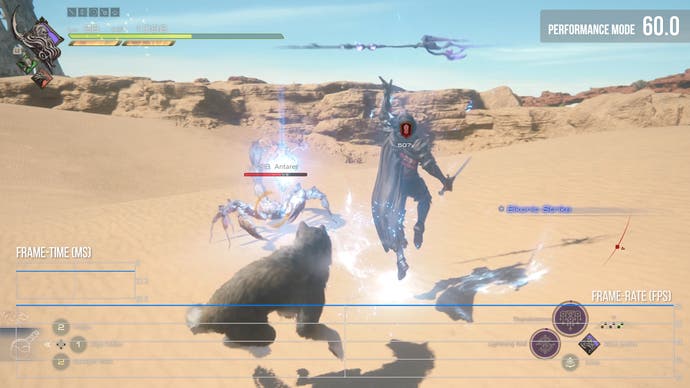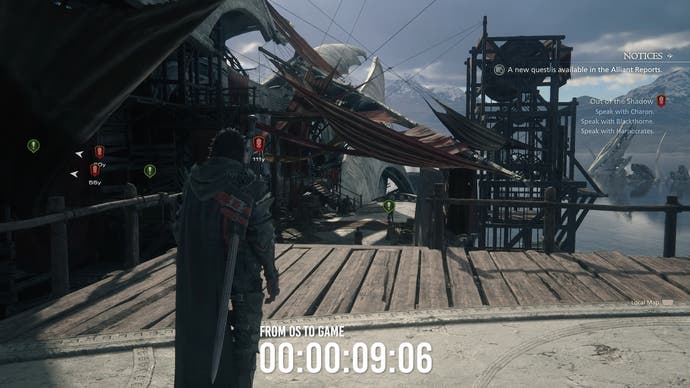Final Fantasy 16: as close to flawless as we've seen in a long time
A highly polished launch experience - but performance mode needs improvement.
With new worlds to explore, characters to meet, and battles to fight, all paired with a world-class soundtrack and a sharp presentation, Final Fantasy 16 arrives in excellent condition and gives players exactly the experience the developers intended. It's one of the most polished games we've seen this year on a technical level, taking into account elements from visuals and audio to technology and performance. It's not quite flawless, but it's as close as we've seen for a long time - and that's worth celebrating.
Unlike most long-running series, each mainline Final Fantasy entry is unique, and FF16 is no different. Helmed by Creative Business Unit III within Square-Enix, 16 is a gorgeous action RPG that plays with expectations for the series even more than usual. It's fast, it's action-driven, and its story is dark and political, resembling the likes of Vagrant Story and Final Fantasy 12.
Rather than using an off-the-shelf engine, Final Fantasy 16 is also built using technology created for this game - at least in part. Square has been remarkably tight-lipped, but it's likely we're seeing an evolution of work done originally for Final Fantasy 14, albeit greatly enhanced. As a PlayStation 5 exclusive, the development team has the freedom to implement new features designed for the new hardware. It's not the most cutting-edge experience on the market, mind you, but what's here is so remarkably solid and polished that it's hard not to be impressed.
There's plenty to cover here, so let's start with the game's cast of characters, looking at character rendering and animation, before tackling environments, performance and other elements of the game's presentation like audio.
As a story-driven series, characters are at the heart of Final Fantasy, and that remains true in 16. This new game features exceptionally detailed and expressive character models, packed to the brim with micro-details. The development team has reached a point where the real-time cutscenes in this game are beginning to resemble the pre-rendered videos of the past.
Interestingly, the characters aren't meant to be photorealistic; they're basically focused on the Square-Enix house style of character design. Fancy hair, smooth skin, and detailed outfits are key, but at the same time, FF16 is more grounded than usual, striking a middle ground. The facial and hair rendering certainly stands out to me - they don't use a strand-type hair system, just the usual alpha texture maps, but the design is sublime. Face textures feel reasonably realistic and stand out in scenes where dynamic lights dance naturally across their surfaces.

Clothing and armor are also beautifully crafted materials - leather, fabric, and metal all have amazingly realistic properties, despite the stylised characters. This allows for the natural interplay of light and shadow, elevating the presentation.
The question is how does this actually work? I've had a hard time answering, but the shadows in this game have more of the characteristics of ray-traced shadows than traditional shadow maps. Now, they could be using another method, including virtual shadow maps like Unreal Engine 5 or even sample distribution shadow maps, but either way the result is what matters.
In practice, this allows character self-shadows to be so clean and generally free of artefacts, as traditional shadow maps normally struggle to resolve fine detail - but Final Fantasy 16 looks pristine. The shadows also have proper contact hardening, so the closer you are to the shadow caster, the sharper and more defined the shadow. All those little crevices you'll find around the model are perfectly shadowed.

But what good is a detailed character without fluid animation? Thankfully, Final Fantasy 16's main sequences are among the best in the business, if not always perfect.
Like other story-driven AAA games, scenes are weighted based on their content - an epic showdown between the player and one of the key villains is obviously more important than small talk with a shopkeeper and deserves more attention, but ideally developers want to avoid a jarring quality difference between these two scenes. This is something Horizon Forbidden West absolutely nailed, with supremely well directed and beautiful main cutscenes as well as well-animated idle chitchat with NPCs, thanks to Guerrilla's powerful scripting system. However, this is uncommon and most games present B- and C-tier sequences as little more than character models standing next to one another, bobbing their heads.
Square-Enix doesn't quite avoid this, with exceptionally detailed, beautifully directed A-tier cinematics that use high-detail models and smooth animation with minimal clipping alongside excellent per-pixel motion blur and glorious bokeh depth of field. Most of these are real-time (with some exceptions such as the opening battle sequence), which is impressive, but the high standards of the A-tier cinemations mean that B- and C-tier sequences where characters generally stand around moving their hands and bobbing their heads can feel slightly below par as a result. Still, the overall presentation of Final Fantasy 16's cast is of generally excellent quality and one of Square-Enix's greatest achievements to date.

Of course, there's more to animation than just cutscenes and Final Fantasy 16 largely succeeds in gameplay as well. While movement can feel slightly odd at first, what with the bounding box that constrains protagonist Clive's movements, but after you get used to it you can appreciate the animation intricacies including proper foot inverse kinematics and dramatic lurches as you swing your weapon.
Combat feels fantastic as a result - Clive moves effortlessly, dancing around the scene as particles burst from your attacks each triggering an explosive showcase of lighting. If you pay closer attention to Clive's gear, note the robust cape physics and the way in which clipping is minimised - the sword feels plausibly attached to his back via a sheath. It's not just floating there, nor does his clothing clip through it.
There is one elephant in the room to discuss, however - the motion blur. Personally, I'm a big fan of the motion blur and selected shutter speed in this game, which accentuates Clive's movement and lends the game a cinematic appearance that elevates the overall presentation. However, based on the demo, not everyone agrees, and players should be allowed to disable motion blur if desired - at least during gameplay. Still, from my perspective, everything about the character rendering and animation from cutscenes to gameplay is a victory.

Yet, there's so much more to Final Fantasy 16's visual design, namely its environments. The game isn't an open world, but many of its beautiful and interesting areas are directly connected to create the illusion of a large explorable space. The world is divided into several large chunks too, which enables a varied design with magnificent medieval cities, underground castles, small settlements nestled among beautiful ruins, vast open fields and scorching deserts to name a few. Fast travel points are accessed from an overworld map, but these points are often grouped together to allow for over-land travel.
There's no dynamic time of day, so the lighting appears to have been baked out as light maps. The advantage of this is that you can achieve some very dramatic results as light from exterior spaces spills into the interior. This is coupled with a robust ambient occlusion solution that ensures that objects close to surfaces or other objects have natural shadowy depth. Many areas just packed to the brim with fine detail too, with liberal use of high-density geometric meshes and detailed textures.


You may remember that Final Fantasy 14 received flak for its low-poly grapes, and it seems the developers took this to heart, so a vineyard in the game boasts thousands of individually modeled grapes nestled between bundles of leaves - incredible stuff.
There's even good use of motion within many of the environments - a wind simulation allows grass and trees alike to shake and tremble before you, while large, scripted explosions can sometimes rip the scenery apart before your eyes. The impressive shadows we mentioned earlier relation to character rendering are also key for environments, with contact hardening and diffuse shadowing providing a realistic look and grounding characters within the scene. The particle system also plays an important role, which allow ethereal particles to glide effortlessly through scenes as torches dance and flicker. The use of fire greatly enhances many scenes, with deep orange hues bringing the world to life.

All of this sounds great then, but I do have some nitpicks to raise. Firstly, the visuals tend to be at their best in dimly or indirectly-lit scenes. The brighter, more directly lit areas are less impressive and more readily resemble Final Fantasy 14's visuals; it feels rather cross-gen. Water too is a mixed bag. The larger oceans are gorgeous with undulating waves and sunlight playing across its surface, but smaller bodies of water suffer from mediocre screen space reflections.
Still, when it all comes together, you're left with some truly remarkable sequences. The Eikon battles combine richly detailed backdrops, impressively articulated, high-detail models and special effects galore to create some truly amazing set pieces. The scale is off the charts - the kind of battles that recent God of War games shied away from and it all moves so fluidly with objects whipping past the player accentuated by the motion blur effect to bring the whole scene together. At its best, Final Fantasy 16 sings.
Unfortunately, as you'll find out, depending on your settings, it may not always be at its best in regards to image quality and performance. Final Fantasy 16 offers players the choice between quality and performance modes, with both using aggressive dynamic resolution scaling (DRS) and TAA to reduce shimmer and noise. Quality mode is typically 1080p to 1440p, upscaled to 4K, while performance mode seems to top out at 1080p but often drops lower.

This is all perfectly normal, but based on analysis of still shots we think the game is using AMD's FSR 1 rather than the newer and better FSR 2. All the telltale signs are there, including swirling, circle-like patterns evident in many scenes. This isn't a huge problem in quality mode, given the higher internal resolution, but performance mode often devolves into a screen full of noisy artefacts. Frankly, this solution just isn't up to the task.
Performance mode also uses lower settings, with shadow quality exhibiting more dithering and distant shadows looking much worse as it makes cascade transitions visible. Pop-in is also increased, which can be jarring in certain areas. Both modes also use time sliced animations for distant enemies in the larger fields, which is a bit distracting if you notice it.
So while quality mode isn't perfect due to its reliance on FSR 1, it still looks great - and it delivers a solid 30fps experience about 99 percent of the time, with just a handful of large-scale battles and certain scenes exhibiting frame drops.

Unfortunately, performance mode delivers noticeably poor image quality throughout and also suffers from an unstable frame-rate. This was first noticed in the demo, and reappears in the full game even with the relatively small 300MB day one patch installed. In side by side tests, any improvement is negligible, with regular dips below 60fps and even below 48fps - so you're falling out of the PS5's 48Hz VRR window.
Weirdly though, I discovered something very strange about this mode - the frame-rate dips while running through the world, but the moment you start combat, the frame-rate rockets up to a near-perfect 60fps. The second Clive puts away his sword following combat, we're back to poor performance.
It turns out that when the developers mentioned they were targeting 60fps in battle only, they meant exactly that. The second you initiate combat, the internal resolution drops like a stone, hitting as low as 720p in the process. Image quality takes a gigantic hit and the game winds up looking more like an oil painting - but the frame-rate smooths out considerably. My theory is that the developers intentionally increase detail while exploring the world then dial back resolution and perhaps disable certain world simulation features to ensure smooth performance in combat. Cutscenes work similarly, playing back at 30fps to ensure good image quality during major sequences.

It's an interesting strategy that makes the performance mode more usable, but it perhaps doesn't go far enough. Without knowing what their rendering budget looks like, I think settings should be reduced even further during both exploration and combat, and FSR 1 should be swapped out for FSR 2 or another better solution. Perhaps there's not enough headroom, but I do feel there is a path to 60 - at least in theory.
Based on the current patch then, I personally would suggest sticking with quality mode, but if you do value the extra responsiveness in combat then performance mode is a viable alternative.
Regardless of mode, loading times are excellent, taking full advantage of the PS5 hardware - there are no actual loading screens anywhere, with the game dipping to black and then fading in the next scene, making it feel like an old-school cartridge game. This also extends to continuing the game from the PS5 home menu, which skips the company logos and drops you back in your latest save file in less than 10 seconds.


Finally, let's talk audio. Music is one of the pillars of the Final Fantasy franchise, and Masayoshi Soken, the mastermind behind Final Fantasy 14's sublime soundtrack, returns in the new title. The game's soundtrack, which spans eight CDs, is one of the best in the series' history, with wall-to-wall perfect songs from the beautiful crystal theme remix to evocative exploration music and incredible tracks backing set pieces. It's the latter that are the most impressive, with dynamic and expressive qualities that capture the imagination and touch the depths of your soul. The music is perfectly matched to the action on screen, which feels just incredible.
The vocal performances also shine, and are possibly the best in the series' history. It's a small bummer that only the English language voices are lip-synced properly, as I've heard the other languages are well-handled, but at least the game supports proper surround sound and makes excellent use of low frquencies.

So as you may have guessed from this titanic article, I really enjoyed my time with Final Fantasy 16 and wanted to talk about it. The storytelling and story are high points in the series, the environments are beautiful and the combat is simply sublime. It might be a little on the easy side, and performance mode has its issues, but it's just a hugely satisfying game to play and a real love letter from the development team.
When technology and art work in harmony, with glitches and bugs nowhere in sight, it allows you to trust a game and savour that experience. After what feels like a long time covering games with serious issues and bugs at launch, I'd almost forgotten what it was like to play something this solid - but between Final Fantasy 16 and Tears of the Kingdom I'm feeling more invigorated about our gaming future.










